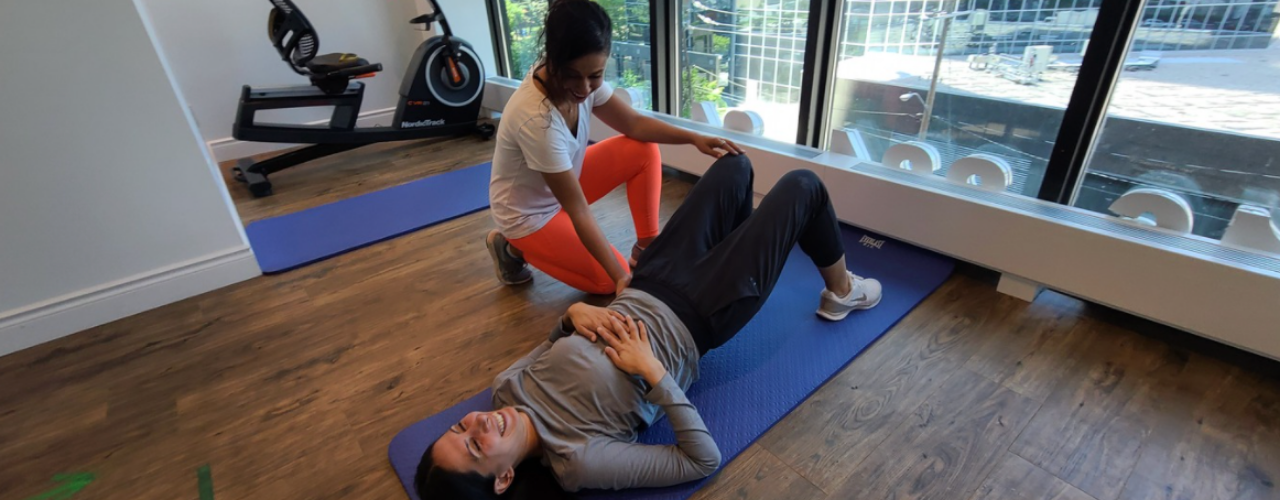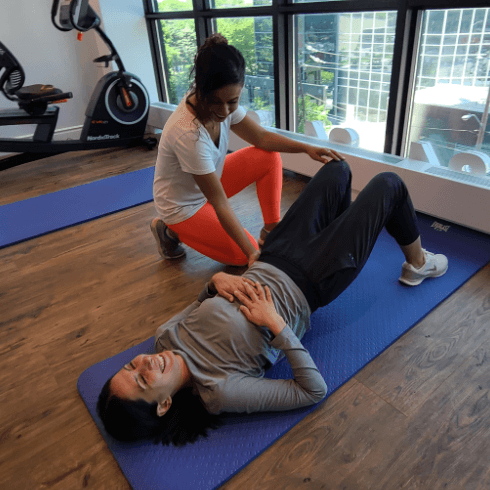Have you been living with pain or discomfort in your pelvic area? Have you experienced incontinence or a voiding dysfunction that interferes with your daily routine? You are not alone.
Pain in the pelvic area, incontinence, and issues with voiding are very common and have the potential to limit daily activities, disrupt routines, and prohibit one from performing the duties or activities that one likes doing on a regular basis.
Pelvic floor physiotherapy helps alleviate symptoms of pelvic dysfunction. Physiotherapy enhances muscular strength and coordination that is required for a healthy pelvic floor function. Pelvic floor rehab seeks to address current discomforts while preventing them from recurring or increasing in the future.
What is pelvic floor physiotherapy?
Pelvic floor rehabilitation is a type of physiotherapy that has been demonstrated to help with a range of pelvic related issues.
Pelvic floor conditions such as incontinence and voiding dysfunction as well as pain and discomfort can be treated with physiotherapy in a number of ways. Pelvic floor physiotherapy can also help examine and improve painful intercourse as well as pelvic organ prolapse, dyspareunia, and diastasis recti.
A pelvic floor physiotherapist provides internal assessment (through vagina or rectum) to check the range of motion, health, and strength of the soft tissue that surrounds the pelvic organs. By providing the proper feedback, education, and soft tissue work a pelvic floor physiotherapist helps relieve pain and/or bring back the strength to pelvic floor muscles which would ultimately improve the function of pelvic organs.
Common conditions pelvic floor rehabilitation can help relieve
Pain
Pain in the pelvic area is very common, although it is not something that we often talk about. Very frequently pelvic pain arises from soft tissue imbalances inside the pelvic floor: a strained muscle or tight soft tissue that has developed secondary to a weakness. Many times even when the pelvic pain has not initially arised from the pelvic floor imbalances, the weaknesses and tightnesses of the soft tissue of pelvic floor can be major contributing factors to pain in the pelvic area. That’s why pelvic floor physiotherapy can be very beneficial for pelvic pain! Because these soft tissues are not palpable from the outside and thus, not assessable without an internal palpation, the pelvic floor physiotherapist performs an internal assessment through vagina or rectum (and always within the tolerance and comfort of the patient) to determine the source of the pain, and help eliminate or reduce it with proper treatments.
What are some common conditions that are associated with pain in the pelvic area? How can Pelvic Floor Physiotherapy help?
Following abdominal or pelvic surgeries
If you are recovering from a recent surgical operation around your lower abdomen and pelvic area, pelvic floor rehab can help loosen up the scar tissue and regain range of motion and strength in your abdomen/pelvic region. This will eliminate symptoms of pain and discomfort on the tissue and prevent future complications that may arise due to weakness and immobility.
With intercourse: Dyspareunia and Vaginismus
Pain with intercourse is commonly referred to as “dyspareunia.” It can be sharp or intense and can happen just before, during, or after penetration.
Vaginismus is another term used to describe pain associated with sexual intercourse. With vaginismus the pain is normally associated with soft tissue imbalances and can have relations to psychological stressors and fears that may require further attention.
Pelvic floor rehabilitation can teach relaxation techniques and provide manual therapy to bring range of motion and health back to the muscles of the pelvic area. This can help relieve and eliminate the symptoms of pain and discomfort during or after intercourse.
On the superficial tissues: Vulvodynia, Vestibulodynia & Clitordynia
The superficial tissues of the pelvic floor include the first layer of muscles as well as the skin of the perineal area. Sometimes these tissues get irritated and painful to touch and palpation. Vulvodynia, Vestibulodynia and Clitrodynia are all conditions that can benefit from pelvic floor physiotherapy. Vulvodynia is the term used for irritation of the vulva (outer part of the female genitals), Vestibulodynia is the term used for irritation of the vestibule (smooth surface inside the outer part of female genitals that includes opening of vagina and urethra) and clitordynia is the term used for the irritation of the clitoris (female erogenous organ that is located in the anterior apex of the vulva).
If you have been diagnosed with any of these conditions, pelvic floor physiotherapy can help you desensitize the tissues that cause irritation and burning sensation, gain back your range of motion, regain strength and thus help treat your symptoms.
On the deeper tissues: Endometriosis, Interstitial cystitis, etc.
Endometriosis is a prevalent disease that affects many individuals. The term endometriosis is used when endometrium, the tissue that normally grows inside the uterus, grows outside of the uterus. Since this tissue can grow and cause bleeding outside of the uterus it causes pain and discomfort on and around the area that it has grown and thus, it can be a very limiting condition.
Interstitial Cystitis is part of broader conditions categorized as painful bladder syndrome (PBS). It is a chronic condition which causes feelings of pain and pressure in the pelvic floor and perineal area. It can be associated with persistent urinary urgency and pain after intercourse. The exact cause of the Interstitial Cystitis is unknown but there can be many contributing factors to the pain in the pelvic area in this condition, including lack of coordination and tightness of pelvic floor muscles.
Pelvic floor rehabilitation can help treat the pain and other symptoms associated with endometriosis, interstitial cystitis and other similar soft tissue conditions of the deeper pelvic floor region. Pelvic floor rehabilitation can teach relaxation techniques and provide manual therapy to bring range of motion and health back to the muscles of the pelvic area. It can help desensitize the nervous system and break the cycle and wiring of pain.
Incontinence
“Urinary incontinence” is a technical term for involuntary leakage of urine. “Fecal incontinence” is a term used for involuntary leakage of stool. These conditions are way more common than what most people think, and can affect anyone at any age with any gender.
Incontinence may have different types, such as urgency (sudden urge to use the washroom and inability to hold), frequency (using the washroom more frequently than usual), stress incontinence (losing control with sneezing, coughing, laughing, or with daily or sport activities such as running) and mixed incontinence (two or more of the above mentioned conditions happening at the same time).
Fortunately, incontinence can be controlled and/or treated with the help of physiotherapy. If you have been struggling with urinary incontinence and you are looking for help, contact PhysioD today to schedule an appointment with our dedicated Toronto, ON physiotherapist.
Why am I experiencing incontinence?
There are several reasons why someone may leak urine or stool. Some short-term incontinence may develop and disappear on its own due to temporary conditions. Certain medications can even cause temporary control problems that should clear up after use. However, if your urinary or fecal incontinence persist, it may be due to a larger underlying condition, such as:
- Weak pelvic floor muscles
- Overactive pelvic floor muscles
- Pelvic organ prolapses
- Pelvic organ conditions (such as prostatitis)
- Post surgeries
In addition to the different ways in which urinary incontinence can be caused, there are also different types of incontinence that can occur. These different types of incontinence include:
- Stress incontinence. Stress incontinence is caused when one experiences a leak due to pressure on the bladder or rectum. For example, stress incontinence can occur when exercising, lifting heavy objects, laughing, coughing, or sneezing.
- Urge incontinence. Urge incontinence is caused when there is a sudden and emergent need to urinate. Someone experiencing urge incontinence may not have enough time to make it to the toilet before leakage occurs.
- Frequency incontinence and voiding dysfunction. This type of incontinence is caused when the pelvic floor is either too weak to hold onto a minimal amount of urine or stool, or is uncoordinated and thus dysfunctional in a way that the person has a hard time emptying the bladder or rectum fully (thus needs to use the washroom more frequently than usual). People with this type of incontinence may also experience urine dribbling or straining with bowel movements.
- Mixed incontinence. Sometimes a person may experience two or more types of incontinence at the same time.
If you are experiencing persistent incontinence that has been occurring for several weeks or months, contact our Toronto, ON physiotherapy office as soon as possible to seek help.
How will physiotherapy help with my incontinence?
When you arrive for your initial assessment, our physiotherapist will take your medical history and will ask about the specific details of what you experience. Our physiotherapist will then perform a physical examination that includes an internal (through vagina or rectum) palpation to determine the overall muscle tone and strength of your pelvic floor and surrounding tissues. Your physical exam, along with an evaluation of your medical history and discussion of your symptoms, will help in determining the best route for your treatment plan. Typical treatments for those struggling with incontinence include:
- Increasing strength, stability, and endurance of the core, lower back, abdominal, hip and pelvic floor muscles.
- Increasing synergy and pattern of muscle firing between the pelvic floor and core.
- Performing strengthening exercises in functional and dynamic positions.
- Improving posture/positions.
- Participating in an exercising/walking/mobility program.
- Participating in functional activities.
- Participating in a home exercise program and instruction.
If you are struggling with incontinence and are looking for help, contact us at PhysioD today to schedule an appointment. Our physiotherapist will get you started on the path toward control and relief.
Voiding Dysfunction/Constipation
Voiding Dysfunction means lack of coordination between the muscles that control the function of the bladder. It can be caused by injuries to the nervous system or by pelvic floor weaknesses, tightnesses and daily habits that have grown over time.
In many cases, lack of strength and range of motion in the pelvic floor, which can cause voiding dysfunction, can also be a major contributing factor to chronic constipation. People with pelvic floor dysfunction have a hard time relaxing and coordinating the pelvic floor and abdominal muscles during evacuation.
Depending on the nature of the condition, pelvic floor rehabilitation will concentrate on relaxing/strengthening the muscles surrounding the bladder and rectum in order to control and eliminate the dysfunction.
A physiotherapist will help you determine the source of the dysfunction and lack of coordination and will address it with proper releasing/strengthening techniques to enhance coordination and eliminate the cause, rather than merely treating the symptoms.
Are you ready to learn more about pelvic floor treatment?
In certain circumstances, our therapeutic procedures will aid in the alleviation and rehabilitation of patients who have been battling issues for years.
Our physiotherapy clinic in Toronto, ON is fully prepared to diagnose and treat all forms of pelvic discomfort. Make an appointment with us today if your pelvic pain is limiting your activities. You deserve to live life according to your terms, without the constant plague of discomfort and limitations.


